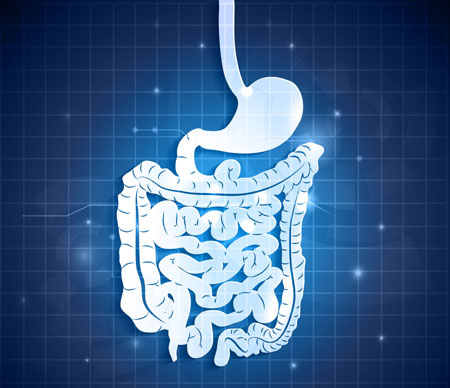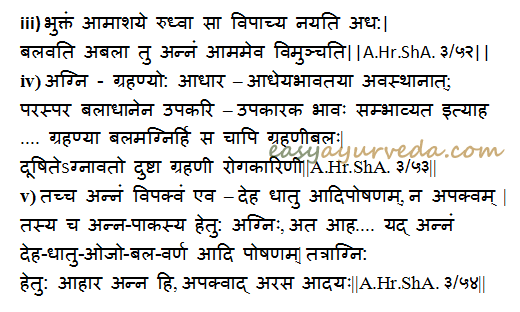Pachana Karma: Physiology Of Digestion As Per Ayurveda
By Vd.A.Rangaprasad Bhat
Table of Contents
Introduction
The Pachaka type of Pitta, that resides in stomach and intestines is responsible for digestion process. It is responsible for digestion and absorption of food particles into the body.
i) “अन्नस्य पक्ता पित्तं तु पाचकाख्यं पुरेरितम्| दोषधातुमलादीनामूष्मेत्यात्रेयशासनम्”||A.Hr.ShA. ३/४९||
सर्वाङ्गसुन्दरी व्याख्या ( कृत):- तुरवधारणे| अनेकविधस्याहारस्याभ्यवहृतस्य पित्तमेव पक्ता| किम्भूतं पित्तम् ? पाचकाख्यं पुरेरितं,-पूर्वं दोषभेदीयेऽध्याय उक्तम्| यथा (हृ.सू. अ.१२/१०)-“पक्वामाशयमध्यगम्” इत्यारभ्य यावत् “पाचकं नाम तत्स्मृतम्|” इति| तदीद्दृश पित्तमाहारं पाचयतीति धन्वन्तरिमतम्| दोषधात्विति| ओत्रेयस्य-अत्रिपुत्रस्य, शासनं-आज्ञा, इति-एवं, दोषादीनामूष्माऽग्निरिति| दोषाः-वातादयः, धातवो-रसादयः, मलाः-मूत्रपुरीषस्वेदाः, आदिशब्देन दूषिकादयः| तेषां दोषादीनां सम्बन्धी ऊष्मा-अग्निः, यः स एवान्नस्य पक्ता, न तु पित्तं पाचकाख्यमिति|

(Controversy: Though the widely accepted fact is that the pAcaka pitta causes the digestion of food, Atri putra (follower of Atreya school of thought) validates, that the ushmA of the Dosha, Dhatu, and Mala is to be considered as pAchakam and not the pachakAgni alone. Probably this statement can be accepted, if one considers that the process of digestion starts from oral cavity and ends in anal canal)
Adhishtana of food
ii) AdhiSThAna of food:-
तदधिष्ठानमन्नस्य ग्रहणाद्ग्रहणी मता| सैव धन्वन्तरिमते कला पित्तधराह्वया|| A.Hr.ShA. ३/५०|| आयूरारोग्यवीर्यौजोभूतधात्वग्निपुष्टये| स्थिता पक्वाशय द्वारि {it stays as a door (dvAri) for pakvAshaya} भुक्त मार्ग आर्गल (bolt or check point !?) एव सा|| A.Hr.ShA. ३/५१|
The seat for process of food digestion is supposed to be grahaNI (structurally the, pyloric end of stomach to 3rd part of duodenum), since it is at the place of grahaNi the food stays for a longer time and that acts a a check point before sending out the processed food (chyme) to the pakvashaya. Being a seat for the Pittadhara kala, the grahani plays a role in prividing the necessary nutrients to maintain the ayush (life), Arogya (health), vIrya (stamina), Oja (immunity) and further helps in the proper functioning of the bhUtAgni & dhAtvagni (biochemical pathways involved in metabolism of tissues).

iii) भुक्तं (The consumed food)
आमाशये (in the pyloric end of stomach)
रुध्वा ( stasis)
सा (refers to grahaNI)
विपाच्य (digests them through various biochemical processes)
नयति (forwards it or brings)
अध:| (downwards – structure lying beneath it)
बलवति (if biochemical functioning of graNi is strong)
अबला (in case if grahani’s biochemical function is weak)
तु (then)
अन्नं (digested chyme )
आमं (undigested chyme)
एव (respectively)
विमुञ्चति (pushes forward to next structure)||५२||
The ingested food which reaches the stomach in raw state(Amam annam), over its pyloric end (which is part of grahaNi) gets stalled for initial stages of the process of digestion through various intrinsic biochemical processes (ChakrapANi- vividjai: prakArai: pAcayitvA ||) and pushes it to the next structure. From where in it reaches the grahaNi propria and gets digested further to produce the chyme. When the agni in the pittadhara kala of the grahani is actively working the ingested food becomes the reason for a properly digested chyme, and when the agni reacts in a weaker mode with the semi processed food from AmAshaya, it results as undigested chyme which technically is referred as Ama.
iv)Based on the cause and effect theorem, the agni and grahaNI are mutually inter related. And thus the strength of the compactly working grahaNI is dependent on the strength of the agni present within. The malfunctioning agni (bio chemical mechanism) in the grahaNI becomes the cause for manifestation of diseases.
V) It is to be hence understood that it’s the pAka annam (properly processed chyme) which is responsible for the nourishment of the body and its tissues and not the apakva annam (unprocessed chyme). The agni (biochemical factors) being the sole factor for the complete digestion is responsible for maintaining the nourishment body, tissue elements, immunity, physical strength, complexion etc. And when the agni causes disruption in the processing of chyme (अपक्वाद्), it becomes responsible for अरस आदयः (आहाराद्रसरुधिरादयो न सम्भवन्ति), i.e.., the AhAra rasa and its dependent rasa, rakta, mAmsa etc dhAtu formation and their nourishment gets faltered or defective.
vi) “न ह्यपक्वाद्रसादयः” इत्युक्तम्| अतः पाकस्यैवेतिकर्तव्यतां निरुपयन्नाह—-अन्नं कालेऽभ्यवहृतं कोष्ठं प्राणानिलाहृतम्| द्रवैर्विभिन्नसङ्घातं नीतं स्नेहेन मार्द्वम्||५५|| सन्धुक्षितः समानेन पचत्यामाशयस्थितम्| औदर्योऽग्निर्यथा बाह्यः स्थालीस्थं तोयतण्डुलम्|| A.Hr.ShA. ३/५६| The statement literally means ” The food that which had been on time sent downwards from the oral cavity to the stomach through the oesophagus by the initiative of the prAna vAyu (cranial nerve and autonomous functions involved), by means of the sneha amsha (oily portion) present in it in the form of curd, ghee etc, the agni in the grahani gets ignited with the help of samAna vAyu (vagal control) and thus aids the process of digestion occuring uninterrupted and complete. The simile of air helping the fire in making the rice grain get boiled kept over a vessel is being presented as an example in above verse.
Though it literally means as above, its interpretation over scientific plane be taken as, the following. The cranial nerve and its related autonomous function in the process of mastication involved are different from the cranial nerve that which control the lower parts of the digestive system. It may be noted that the Buccinator (controlled by C.N.VII), saliva (controlled by C.N.VII—chorda tympani and C.N.IX—lesser petrosal), the intrinsic muscles of the tongue (controlled by C.N.XI) hyoglossus (contolled by C.N. XII)) and genioglossus along with styloglossus (both controlled by C.N. XII) are part of the oral phase of deglutition (the other two phases are Pharyngeal & esophageal phases) which involves the above structures with some other structures not mentioned here with in moistening, masticating, trough formation, Movement of the food bolus posteriorly etc 4 sub stages. Where as in the esophageal stage of deglutition it is the C.N X, the vagus nerve, starts taking control of moving the food further downwards.
This makes understand the mention of two kings of vAyu being mentioned in playing a synchronous role along with the grahaNi based agni in conducting the business of digestion of food in a smooth manner as having been mentioned in the context of A.Hr.ShA. ३/५६. Having explained the above verse from the angle of Applied Anatomy, let us divulge into, how Acharya ChakrapANi, clarifies the statement of the main verse of the text.
Chakrapani’s opinion
Chakrapani says- अन्नप्रवेशकृदित्यनेनान्नप्रवेशकरणमात्रमुक्तम्, न तु कोष्ठप्रापणमिति| The prAna vAyu being present in the head – प्राणोऽत्र मूर्धगः, is responsible over here only for sending the food downwards into the oesophagus from the oral cavity by means of the swallowing reflex. It need not be confused with, that the prANa vAyu has its action potential, spreading across the entire digestive system in controlling the peristaltic movement.
This above facts need to be cleared when we read the statement mentioning the involvement of “prANa anilA hrtam, annam abhyavaha hrtam koShTam” as seen in this verse – so, clarifies ChakrapANi.
And from the region of agni, albeit it is only the samAna vAyu which takes control of the movement of the chyme as has been mentioned as “समानोऽग्निसमीपस्थः कोष्ठे चरति सर्वतः|” elsewhere in the context of A.H.sU.१२/८).
vii) तस्य अन्नस्य इदानीम् अग्नि-समीपस्थस्य या अवस्था: ता: कथयन् पुन: तं एव पाकं निर्दिशति—A.Hr.ShA. ३/५७|| What happens when the food gets in contact with the agni and how the 3 stages of pAka named avasthApAka takes place will be henceforth discussed.
आदौ षड्रसम् अपि अन्नं मधुरीभूतं ईरयेत्| फेनीभूतं कफं,…. ||५७|| To begin with the explanation, though the food is inclusive of all the six tastes, the food attains madhura pAka and produces the kapha in foamy appearance. Hence the first stage of annapAka gets denoted as madhurAvasthapAka of annam.
ChakrapANI, in this verse तत्पच्यमानं मधुरीभुतं-अमधुरं मधुरं सम्पन्नं सत्, कफमीरयेत्|, mentions that the taste of the chyme at this stage will be either amadhuram (less sweet) or madhuram.
“………यातं विदाहाद् अम्लतां ततः| पित्तम् आमाशयात् कुर्यात् च्यवमानं,…..”| The pittam moving or circulating (cyavamAnam) in the AmAshaya, by the virtue of its amlatA (acid or sourness) causes vidAha (burning) of the food particles. This second stage is amlAvasthapAka of annam.
“…… च्युतं पुनः अग्निना शोषितं पक्वं पिण्डितं कटु मारुतम्|| A.Hr.ShA. ३/५८|| Moving out from the grahani to pakvAshaya (ChakrapAni – च्युतंपुनः – तत आमशयात्पक्वाशयं प्राप्तं ||) the chyme which had been dried up, post the process of digestion, by the interference of pitta, attains the shape of a bolus (ChakrapANi – जाठराग्निना पक्वं शोषितमन्नं, तथा पिण्डितं-तदानीम् पिण्डं सञ्जातं संहतं सम्पन्नं, तथा कटुकं जातं ||). The chyme attins katu taste and hence this third stage gets referred as Katu pAkAvastha of annam. The dosha that which gets produced at the end of this avastha paka is vAta.
Chakrapani guides that, “एतच्च सर्वं स्वभवसिद्धं स्वसंवेद्यप्रायंकार्यानुमेयं च”| Though the above concept of pAkavastha gets mentioned with the resultant taste of the end product, it is in actual to be taken as an inferred statement, based on the basic principles.
किट्टं सारश्च तत्पक्वमन्नं सम्भवति द्विधा | किट्टमपि यदेतन्नस्य पक्वस्य, तदप्यच्छानच्छभेदेन द्विधेत्याह ———————–| तत्राच्छं किट्टमन्नस्य मूत्रं विद्याद्धनं शकृत्||६१|
The digested chyme ends up as two by products namely the Kittam (residual product) & sAram (nourishing product). Where in the residual products of annarasa, post the stage of annapAka presents as accham (clear) & anaccham (turbid) in consistency and presentation. The clear residue of the kitta annarasa gets further processed to become mUtra and the turbid one as shakrut.
By Vd.A.Rangaprasad Bhat
“Padmanilayam”, (Ayurveda & Non Conventional Marma Chikitsa Clinic) 49/46,
Kanagaraya Malaiyappan St,
Raja Annamalaipuram,
Mandavelipakkam, Chennai- 600028.
Email: [email protected]









